Alaska Fish & Wildlife News
March 2015
Nesting Bears
Bear Dens on Prince of Wales Island
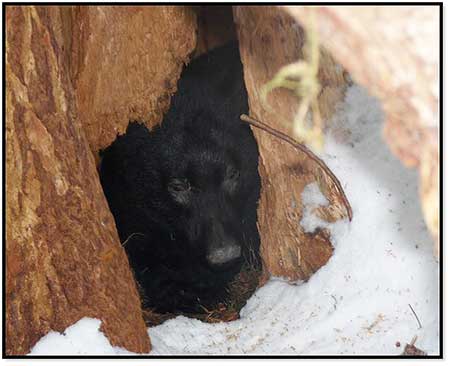
Say “bear den” and for many, the cartoonish image of a cave comes to mind, the entrance littered with bones. Boyd Porter and his colleagues spent the past four years studying black bear dens on Prince of Wales Island in southern Southeast Alaska, and for him the word that comes to mind is “nest.”
“They’re nesters, although people wouldn’t necessarily put them on a list of nesting animals in Alaska,” said Porter, a state wildlife biologist based in Ketchikan. “They bring in nesting materials as a buffer between them and the cold ground.”
Evergreen boughs (hemlock and cedar) are the preferred material, although salmonberry stalks and other vegetation is also used. Porter described bears gathering mouthfuls of material and making multiple trips to the den site in preparation for winter hibernation. These winter bedrooms are not year-round homes for bears, but they are used year after year and represent an important resource for the animals.
“It looks like they add to the nesting material each year, and some of the structures have been around a long time and could be pretty ancient, there is obvious historic use of many dens,” Porter said.
Porter and his crew handled 65 black bears and documented 52 bear dens. All the dens were associated with trees and “woody material,” hollow tree trunks, root wads and cavities. Prince of Wales is famous for its limestone caves, but none of the 65 bears Porter tracked hibernated in natural caves.
“There was also very little use of excavated dens,” he said. “That’s different than the majority of dens in the Interior and in South-central Alaska, where the majority (for both black and brown bears) are excavated and carved into side hills.”
Although the Prince of Wales bears were not digging dens, there was evidence that bears modified the entrance of tree dens, to make it easier to move in and out. “It looked like there were multiple years of use at many sites,” he said. “Like for example a 400 or 500-year-old cedar tree, which could’ve been used for a bear den for 200 or 300 years.”
Some of the most remarkable “nests” really were up high in trees. Some of these “elevated dens” had nesting material that represented multiple trips by the bear, probably climbing the tree with mouthfuls of vegetation to make the winter bed.
Bears were initially captured in summer using foot snares and equipped with radio tracking collars that enabled the researchers to find them at all times of year including in winter. In one case, Porter had a strong signal coming from inside a nearby tree, with no obvious way into the tree. The trunk where the signal was coming from was 40 inches in diameter and very clean on the outside. It became apparent the tree was hollow and the hidden entrance was at the very top where the last 20 feet of the tree had sheared off, maybe during a winter storm. “The bear had climbed up the tree and then down into the deep cavity and was resting peacefully just above our heads,” Porter said.
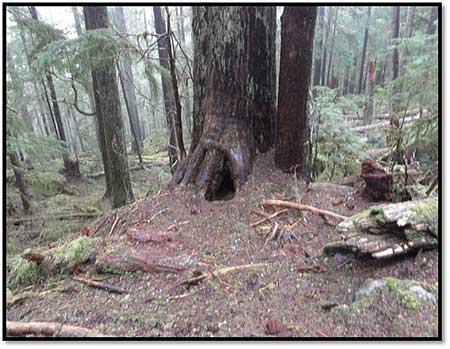
But how would a bear ever find such a den?
“Bears are good at finding those sorts of things,” Porter said. “It makes you wonder if during their daily routines and summer explorations they make a mental note of potential sites and come back later. They probably identify multiple sites, as we had some bears that moved from one den to another in the same winter.”
A wet or flooded den is a likely scenario for a bear relocating during mid-winter, but there may also be other factors that influence a mid-winter move.
Another time a strong collar signal indicated a bear was in a jumble of windfall trees, all lying horizontal in a big pile. “We were climbing under these windfall trees, thinking it was in some cavity under the brush pile,” Porter said. Standing on the horizontal tree trunk with the collar signal blasting, they realized the bear was directly beneath them, inside the hollow tree under their feet. “She was 20-feet straight in the tree and it was very tight quarters inside. We didn’t (re)capture that particular bear because of safety concerns for the bear and for the researchers. It was just too tight to wiggle inside and even if we were able to tranquilize the bear there was no way to handle her or remove her collar.”
Because this portion of the study focused on den site descriptions, researchers did not spend a lot time “processing” bears, as is often done in bear research, where samples of blood, hair, and tissue are taken, a small premolar tooth is pulled to determine the bear’s age, and where bears are often tagged and marked. This work had already been accomplished during the summer capture. Researchers conducted a quick health assessment of the animals, noted if any cubs had been born and counted them, and swapped out the bear’s radio collar for one with fresh batteries. The collar also had valuable location data stored on board the small computer showing everywhere the animal had been with a location point recorded every six hours.
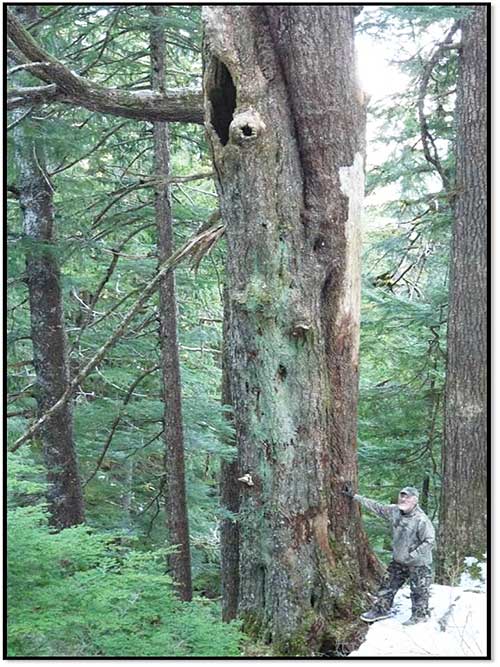
At the 52 dens located during 2010-2013, the following details were measured and recorded: entrance and cavity size, elevation, slope and aspect, distance above or below ground level, nest material type, tree diameter at breast height (DBH), tree species, surrounding timber stand type, and den structure (e.g., standing, downed, dead, logged, roots). Trail cameras were also placed at den sites to document when the bears emerged in the spring, and how many cubs might be present.
One interesting detail is that males denned at higher elevation than females: the average den elevation was 313 meters for males and 193 meters for females. Bears preferred den sites in timbered habitat on steeper slopes.
Crawling into a bear den mid-winter to examine a hibernating bear required precautions to insure the safety of the researchers and the bears. Bears were sedated using a CO2 powered dart gun that delivered a sedative, or a “jab stick” style hypodermic needle.
“We soon realized, after seeing how tight these cavities were, we didn’t want to pull bears out of the den during capture,” Porter said. “We did most of the work in the den so we didn’t have to push and jam them back in – like pushing a 200-pound sack of beans back into a small space. We were concerned for the bears’ safety, and our safety, we talked about a lot of different scenarios with the drugs and bears in the planning process, and took a lot of latitude so that everyone was safe. We also had a carefully written animal care plan that insured the bears were treated well and both adults and cubs were safe.”
Part of the issue is that black bears are not true hibernators, like marmots or ground squirrels, which can reduce their body temperature to near freezing and their heartrate and respiration to just a few beats and breaths per minute. Bears are in a torpor - they are metabolically processing stored fat, although they don’t urinate or defecate. Instead they reabsorb the urine and feces in the form of proteins. This is an amazing evolutionary process that allows bears to live on stored fat reserves and maintain themselves, even giving birth to young during a time when most bear food is not available. They don’t hibernate because it is cold outside but rather because there is no food during winter months. They reduce their body temperature by 7 or 8 degrees and heartrate is reduced somewhat, but they can wake up fast. They still burn about 4,000 calories per day while in hibernation, which is why they need to put on so much fat during summer and fall. Bears can lose 25-40 percent of their body weight during hibernation burning fat for fuel.
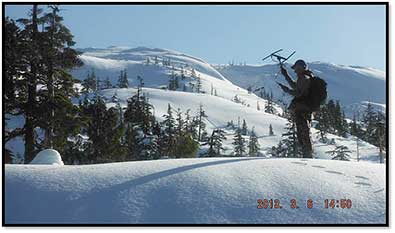
Some days as the researchers approached a den, the tracking signal indicated the bear was up, awake and aware of their presence from a long distance away. “Most bears met us with eyes wide open and fully alert at the den entrance,” said Porter.
Other times they left the den and moved away before the researchers arrived.
“We tried to go in as stealthy as we could, but on some of the cold, crunchy, icy days the noise of our approach was just too much for them,” he said. “That might be a strategy they use for predators such as wolves, not sitting tight in a den if a pack of wolves is moving in. The majority of the dens were not fortified or protected, and several had multiple entrances - not good if you were going to be dealing with a pack of wolves that could kill you and or your small cubs.”
That could make the elevated dens, or standing hollow tree dens, pretty appealing to a black bear. Porter said a bear could be very safe and more relaxed in a really good elevated den. So if bears spend the summer identifying potential den sites, who gets the best ones?
“Who knows, maybe it’s first come first served for available den sites. If a pregnant sow or a sow with last year’s cubs comes to a den and somebody is already there, does she go to the second choice – right on down the list of identified dens that she knows of, or maybe the one she was born in with her mother? A longer term study would tell you, but this project was concluded after four years.”
In nearby British Columbia during a similar black bear study radio-collared bears reused dens seven out of 25 potential occasions. During this long term study in Coastal British Columbia they found 71 percent of the identified dens were reused at least once over a ten year period.
As a wildlife biologist managing a population of black bears, Porter said the take home lesson is that existing dens are a valuable resource that should be protected if possible. That’s especially important in areas that are logged. Not only are the dens removed (the trees that create the dens) in the logging process, but the other old trees that could potentially become den sites over time are also removed.
He paraphrased a statement from a research project in British Columbia, where bears were using root wads and other woody structure as dens, year after year. “If you’re interested in managing black bears responsibly, you should be making special allocation for woody structures and insure there are plenty of potential sites available into the future,” he said.
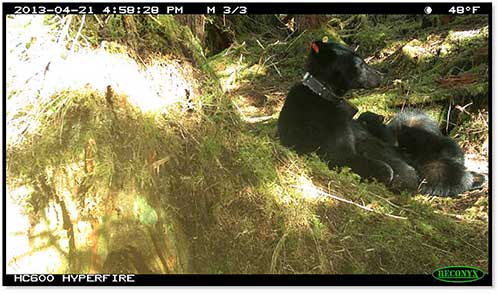
“This could help us in terms of comments on timber sale designs and locations,” Porter said. “We went to the Forest Service with 50-some recent den locations, and suggested they provide some sort of individual tree protection, or a small buffer around these known bear den sites. We discussed den sites with the Forest Service several times and were encouraged by some positive comments from Forest Service staff initially. However, in the end they did not incorporate our den site protection suggestions for some upcoming large timber sales in the same area. There’s nothing in the Forest Plan that says they have to make any allocations for black bear dens.”
Porter and his colleagues are still working with the data they gathered and plan to compare their findings to other work done across North America. Collars provided telemetry information (GPS) that can be used to create maps of the bears’ movements over the course of the year. Researchers will be looking at average times bears entered dens in fall and den emergence times in spring, habitat selection (and whether that changes over time), food resource preferences at different times of the year, and the bears’ activities and movement patterns.
Dave Gregovich, a research analyst working with Porter, said he’s lucky to have such a wealth of data to work with. He participated in initial radio-collaring efforts and he visited dens with Porter and others in winter, and was struck by the cleanliness of the dens. He speculated that may simply be healthier for the inhabitant. A messy den could breed parasites, but a bear nesting in a pile of fresh cedar boughs could be in pretty good shape for the long dry and warm winter.
“The dens that I went to didn’t smell at all, they’re as clean as a whistle,” he said. “For a bear being in a small space all winter, it was cleaner than my apartment.”
For more on Prince of Wales black bears and bear research, see “Bear research on Prince of Wales Island" from AFWN, 2012
A series of trail camera images of a black bear investigating a bucket snare (and evading capture).
Riley Woodford is the editor of Alaska Fish and Wildlife News and participated in bear captures on POW in 2012.
Subscribe to be notified about new issues
Receive a monthly notice about new issues and articles.
